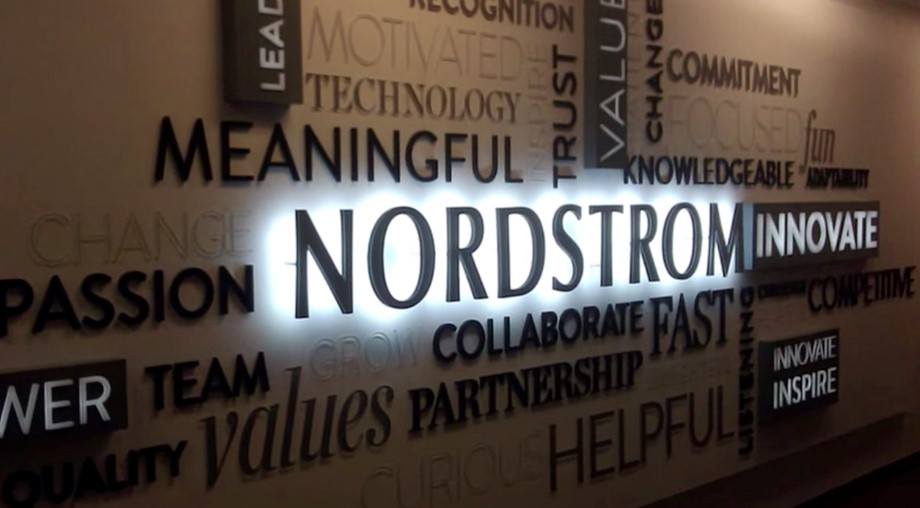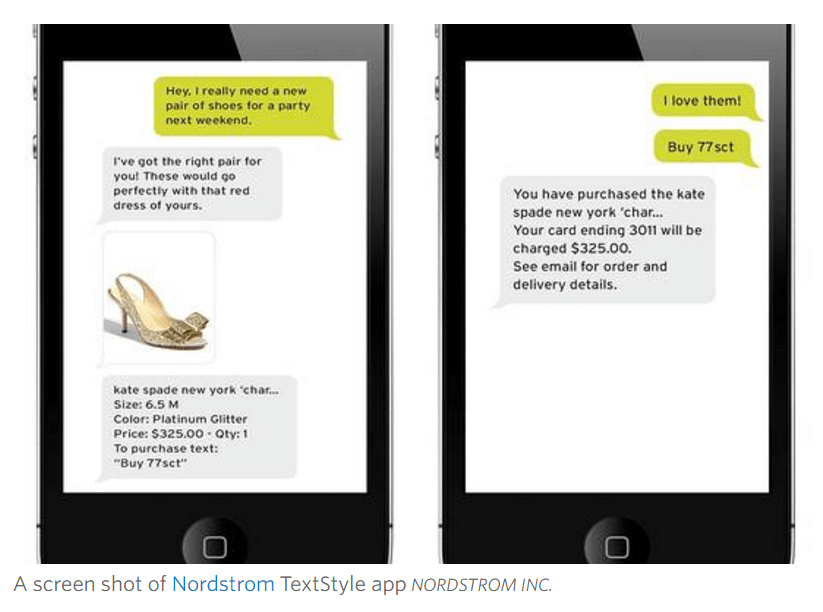What to do when the Internet knocks on your store’s door: Nordstrom goes digital

How can a retail behemoth, dragged down by investment in hundreds of stores keep up with the internet of things? When faced with shrinking Black Friday sales, limited international tourist spending, and declining earnings, where will Nordstrom invest its limited dollars?
The Nordstrom Promise: The Evolution of ‘Customer Service First’
Since its founding, Nordstrom has had a very clear guiding principle: customer service comes first [1]. Historically, it depended on its sales associates to bring this mission to fruition. However, in the 1990s Nordstrom realized that the internet was fundamentally challenging their operating model; customers were engaging in commerce in an entirely different fashion than ever before. In order to continue to provide the highest service and stay true to its value proposition, Nordstrom had to adapt. By 1998 they had launched their e-commerce platform Nordstrom.com and have continued to evolve ever since [2]. They remain dedicated to serving customers on his or her own terms: “Our customers desire a relevant experience no matter how they choose to shop… in stores or online…Our goal is to build a seamless ‘One Nordstrom’ customer experience [3].”
The Nordstrom Way: How Nordstrom Has Operationalized Digital Transformation
As industry alarmists were proclaiming that the emergence of e-commerce meant the death of the store, Nordstrom held firm to its customer promise and swiftly adapted its model. While today they still have over 300 physical locations, they have invested $3 billion in their digital business in just the last 5 years, growing their online net sales by over 50% [4]. By integrating systems, creating a supporting organizational design, and continuing to offer superior customer experiences, Nordstrom has adapted to the new way of doing business:
- Integration of systems: Retailers are dependent on visibility – without the right product, in the right place, for the right person, at the right time, the best customer service means nothing. Nordstrom has implemented two major initiatives to solve the visibility gap posed by the introduction of a new channel. First, in 2002 Nordstrom rolled out a perpetual inventory system that enabled their sales and corporate associates to have visibility of inventory across channels [5]. Second, they launched a new point of sale system to allow associates to track customers purchase behavior and requests on and off line [6].
- Organizational Design: While systems provide the base for successful operations, Nordstrom realized that to operate successfully digitally, they needed to take their efforts a step further. In 2010 Nordstrom launched the Nordstrom Lab, a centralized innovation group funded through IT, to “jumpstart projects aimed at changing the way customers shop [7].” More recently these resources have been embedded into the business to ensure that the digital mindset is integrated into everything that Nordstrom does. Similarly, Nordstrom made significant efforts to ensure alignment between the business, finance, and technology, going as far as creating a Technology Business Office that reports directly to the CIO [8].
- Customer Experiences: As a result of its integration of systems and strong organizational support, Nordstrom has been able to offer its customers numerous digital experiences. From projects that allow customers to buy online and pick up at their store, to TextStyle communication for single text buying, to buyable pins on Pinterest, to acquisitions of e-commerce start-ups such as Trunkclub and HauteLook, Nordstrom has differentiated itself from its competition [9][10].
From Bricks to Clicks and Back Again: What Nordstrom Needs to Consider Next
A recent New York Times article headline read, “An age of online shopping has, surprisingly, led to an exciting time for shoppers to get back out onto city streets to explore new, innovative shops [11].” As the debate regarding “bricks and clicks” rages on, industry experts are cautioning traditional retailers against underestimating their biggest asset, their stores [12].
With increased pressure on profitability and the recent departure of several key leaders in their digital organization, I believe Nordstrom should shift its digital focus from new customer offerings to technologies that improve the operations of its store. Examples of viable technologies include:
- Smart Shelves: Nordstrom is known for its policy of price matching competitors; online this simply manifests as a “Price Matched” label, likely enabled by a few clicks of a junior employee or an automated algorithm. Implementing this in stores requires much more labor and time. In its next phase, Nordstrom should consider investing in “smart shelves” which could allow prices to be changed real time on the store floor [13].
- Beacons: In addition, beacon technology could take Nordstrom’s service to the next level. Thus far they have treaded a careful line of leveraging beacon technology to push targeted messages to customers in store via blue tooth [14]. However, I believe Nordstrom should push to further enable this technology sending personalized information to customers, before competitors beat them to the punch. Retailer Target’s beacon-powered Cartwheel app has already been downloaded by 18M customers [15].
Nordstrom demonstrated it could keep up with the introduction of the internet. The question remains, will its service-centric model be up for the next phase of digital evolution?
(794 Words)
Content Footnotes
[1] Micah Solomon, “What Any Business Can Learn From Nordstrom Customer Service,” Forbes, January 26, 2016, http://www.forbes.com/sites/micahsolomon/2016/01/26/what-any-business-can-learn-from-the-way-nordstrom-handles-customer-service/#546c97b14d45, accessed November 2016.
[2] Nordstrom, Nordstrom Company History, http://shop.nordstrom.com/c/company-history, accessed November 2016.
[3] Nordstrom, Annual Report 2015, p. 4, https://materials.proxyvote.com/Approved/655664/20160311/AR_278376/pubData/source/Nordstrom,%20Inc%202015%20Annual%20Report.pdf, accessed November 2016.
[4] Nordstrom, Annual Report 2015, p.5.
[5] Jake Batsell, “Nordstrom gets in step with tracking its inventory,” Seattle Times, February 10, 2002, http://community.seattletimes.nwsource.com/archive/?date=20020210&slug=nordstrom10 , accessed November 2016.
[6] Jeanne W. Ross, Cynthia M. Beath, and Ina Sebastian, “Why Nordstrom’s Digital Strategy Works (and Yours Probably Doesn’t),” Harvard Business Review, January 14, 2015, https://hbr.org/2015/01/why-nordstroms-digital-strategy-works-and-yours-probably-doesnt, accessed November 2016.
[7] Kim S. Nash, “Nordstrom’s Innovation Revamp Leads to E-commerce Texting App,” Wall Street Journal, May 28, 2015, http://blogs.wsj.com/cio/2015/05/28/nordstroms-innovation-revamp-leads-to-e-commerce-texting-app/, accessed November 2016.
[8] Price Waterhouse Cooper, “Nordstrom: The customer comes first through business partnering transformation,” http://www.pwc.com/us/en/increasing-finance-function-effectiveness/finance-effectiveness-benchmark-study/nordstrom-technological-transformation.html, accessed November 2016.
[9] Nash, “Nordstrom’s Innovation Revamp Leads to E-commerce Texting App,” Wall Street Journal.
[10] Nordstrom, Annual Report 2015, p.9.
[11] Tim McKeough, “Clicks to Bricks: Online Retailers Find the Lure of a Store,” New York Times, November 10, 2016, http://www.nytimes.com/2016/11/11/style/clicks-to-bricks-online-retailers-find-the-lure-of-a-store.html?_r=0, accessed, November 2016.
[12] Anthony Karabus, “Think Tank: How to Combat the Amazon Effect? Reinvest in Bricks,” WWD, October 21, 2015.
[13] Synchrony Financial for Business Insider, “5 ways technology is revolutionizing the way we shop,” Business Insider, October 28, 2015, http://www.businessinsider.com/sc/technology-changing-the-in-store-retail-experience-2015-10, accessed November 2016.
[14] Lauren Horwitz, “Nordstrom Mines Beacon Benefits in Personalized Customer Service,” TechTarget, http://searchcrm.techtarget.com/news/4500246312/Nordstrom-mines-Beacon-benefits-in-personalized-customer-service, accessed November 2016.
[15] Nancee Halpin, “The Future of Retail 2016,” BI Intelligence, https://intelligence.businessinsider.com/the-future-of-retail-2016-slide-deck-2016-10, accessed November 2016.
Images
[Cover] McKinsey&Company, “Digitizing the Consumer Decision Journey,” June 2014, http://www.mckinsey.com/business-functions/marketing-and-sales/our-insights/digitizing-the-consumer-decision-journey, accessed November 2016.
[The Nordstrom Way] Taylor Soper, “Nordstrom to cut up to 400 more jobs, just one month after slashing 130 tech-related positions,” Geekwire, April 18, 2016, http://www.geekwire.com/2016/nordstrom-lay-off-another-400-just-one-month-slashing-130-tech-related-jobs/, accessed November 2016.
[TextStyle] Nash, “Nordstrom’s Innovation Revamp Leads to E-commerce Texting App,” Wall Street Journal.





Great post! As a loyal Nordstrom fan, it was interesting to read about all the digital innovations that Nordstrom implemented to fuel their success. One challenge that many consumers face in online shopping is the paradox of choice, given that they have to sift through pages and pages of clothing options which can be tedious and overwhelming. I wonder if Nordstrom will incorporate algorithms or machine learning to offer personalized clothing recommendations to enhance the digital customer experience.
Great post – really informative and an excellent example of a company getting ahead of the digitization curve. One thought I had after reading was, it seems that despite Nordstrom’s efforts the retail store and e-commerce still operate in slightly separate “worlds” for the consumer. I think you raise some great ideas in your Next Steps section – do you think there is a benefit for Nordstrom, or consumers, in bringing the two even closer together? Or, at this point, are consumers still wanting separate experiences to some degree?